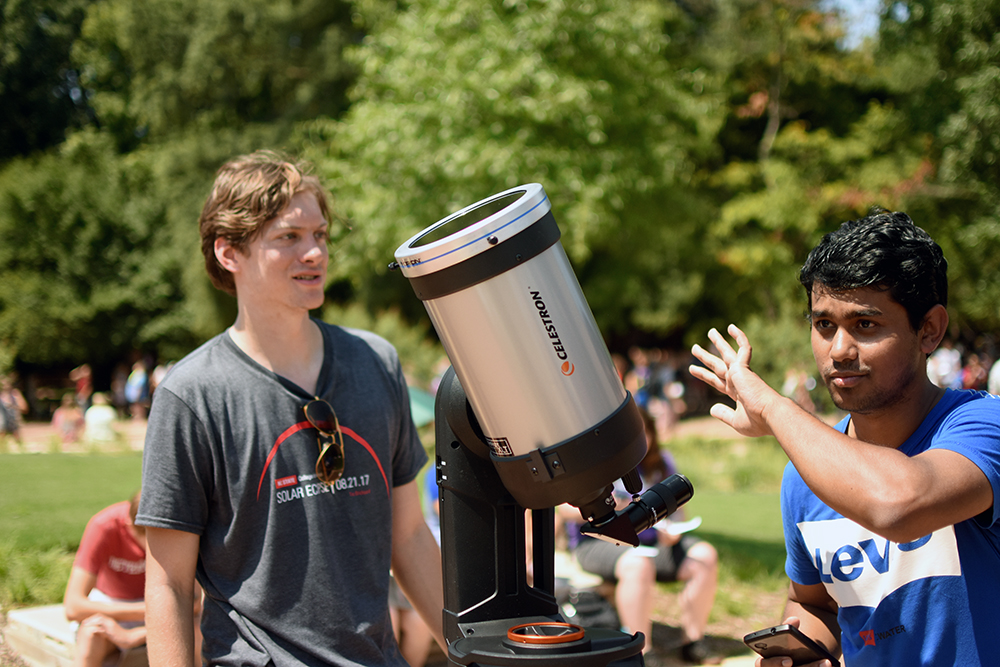Brickyard Eclipse Party Draws Thousands

Samuel Griffin/Staff Photagrapher
Matthew Gilmer, a graduate student studying astrophysics, instructs Md Hafizul Islam, a fourth-year ph.d student studying engineering, on using a telescope on the Brickyard to view the solar eclipse on Monday, Aug. 21. “I was appointed to this by my advisor,” Gilmer said. The telescope was loaned from the College of Sciences, according to Gilmer.
Keilah Davis | Managing Editor
Penny Lawrence | Staff Writer
Over 5,000 students, faculty, staff and community members gathered on Monday to view the solar eclipse in the Brickyard, where the College of Sciences hosted an Eclipse Day celebration. According to the Office of University Communications at the University of North Carolina-Chapel Hill, about 50 eclipse viewing parties were held across North and South Carolina. This event was free and open to the public.
According to NASA, a solar eclipse is when the moon blocks out the light of the sun during its orbit. Raleigh experienced a partial solar eclipse where part of the sun remains visible. During the peak of the eclipse, the sky darkened and attendees experienced a slight drop in temperature, and crescent shadows. Eclipses happen every eighteen months around the world, but the one that happened this week was the first one to cross the United States from coast to coast in 99 years.
Eclipse glasses and simple pinhole projectors were available for viewing the sun. There was a limited supply of glasses and some of the attendees were angry that they ran out.
Yahssain Khan, a second-year student, came to get glasses an hour before the event. “The crowd control was not really great,” Khan said. Over 2,000 people were crowded around the glasses distribution table by the time the event began at 12:30 pm.
Jared Smith, a first-year student studying political science, also had a negative experience with the crowd. He arrived at a similar time to Khan and was one of the last people to get glasses. However, by the peak of the eclipse, the glasses were passed around so that most everyone had the opportunity to view.
Serene Ahmad, a fourth-year student studying biochemistry, said, “It was nice to see how people devised a system to put the eclipse glasses on top of their camera lens to get the whole picture.”
In Raleigh, viewers began to see the moon pass in front of the sun at 1:16 pm. While Raleigh was not in the path of totality, or the region entirely in the moon’s shadow, viewers saw the eclipse peak at 93 percent at 2:44 pm. The moon was completely out of the path of the sun by 4:06 pm.
There were two educational stations under tents spread across the brickyard. At the science station, NC State’s Sounding Club, NCSU Libraries, and the Office of Public Science had tables with information about eclipses and citizen science projects. The resource station featured the City of Raleigh Parks, Recreation and Cultural Resources Department along with advisors from the College of Sciences and Life Sciences First Year Program.
One woman said that she appreciated the educational aspects of the viewing party. “I’ve learned a lot today,” she said. One boy and girl said that they wanted to be physicists in the future.
Among the event’s attendees were local families with children of all ages. One family said that they brought their two daughters to the Brickyard because both loved science and witnessing an eclipse was a rare opportunity. Another family came prepared with cereal box pinhole projectors to view the sun.
Others also brought their own homemade viewing devices. Some were as simple as cardboard boxes while some were more complex and involved heavier hardware like wood and nails. In addition to pinhole projectors and eclipse glasses, attendees could view the sun through a telescope with a solar filter stationed in center of the Brickyard.
At the peak of the eclipse, people filled the Brickyard from the stairs of D.H. Hill Library to Dabney Hall. Some of the people on the stairs started the “WOLF” and “PACK” chant. The people were cheering, as one woman said, for science.
- Categories: